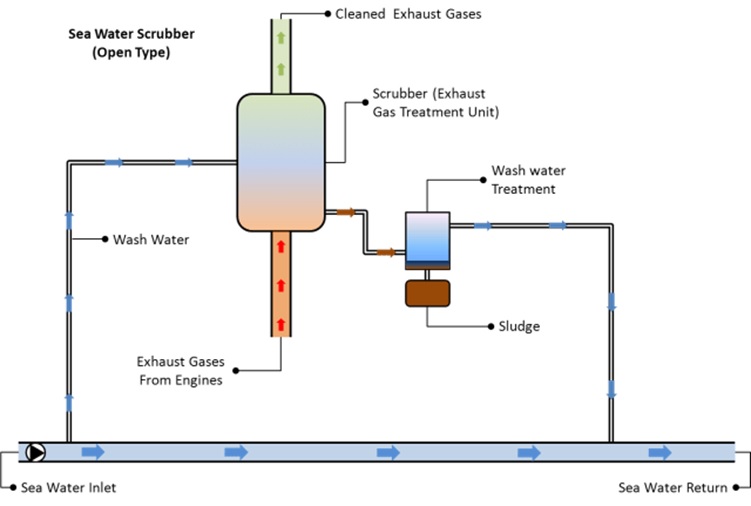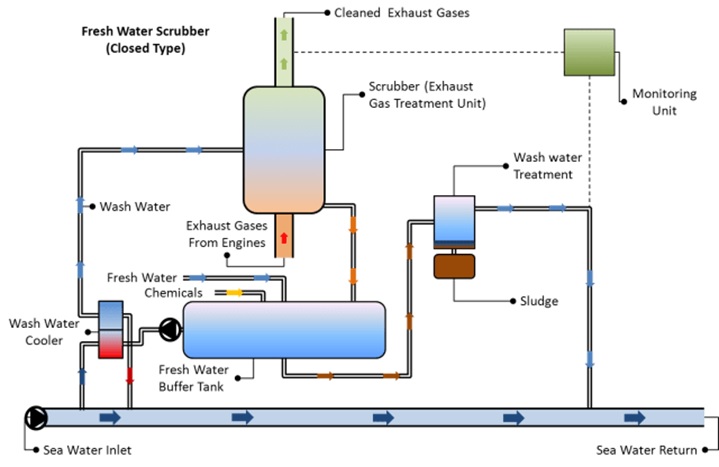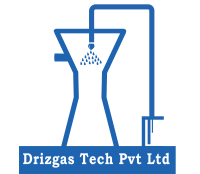Explanation
- Marine scrubbers or vapor cleaning Systems are used to control or eliminate particulate matter and harmful components, such as Sulphur oxides (SOx) and Nitrogen oxides (NOx) from the gases generated from combustion processes of marine engines.
- These scrubber system has been developed to scrub exhaust from engines, auxiliary engines, onshore, boilers and onboard marine vessels, to confirm that no damage is done to human life and the environment by toxic chemicals.
- Drizgas Tech is one of leading manufacturer of marine exhaust scrubber in India. We provide highly efficient, top-quality marine exhaust scrubber system built around your precise requirements.
Classification of marine wet scrubber
- Open loop scrubber system
- Closed loop scrubber system
- Hybrid (Combination of both closed and open loop)


Mechanism
- The polluted exhaust streams are pulled inside the scrubber where an alkaline scrubbing liquid is being recirculated continuously to neutralize the acidic nature of the pollutants, Sox and NOx to remove them quickly.
- As the operation goes on, the scrubbing liquid will be saturated with pollutants and it’s by products, so there will be no space for absorption to continue. The saturated scrubbing liquid is then collected with wash water which may be stored or disposed of immediately as the effluent.
- The cleaned gas will come out of the system and will be released into the atmosphere. The scrubbing liquids are chosen based on pollutant nature like SOx or NOx can be removed easily by suitable chemical reactions.
- Generally, the marine scrubbers use caustic solution or lime soda and after the treatment, sulphur based salts will be produced as by products, which can be easily disposed as they do not cause any threat to the environment. The scrubber may use sea water, fresh water with added sodium or calcium sorbents or hydrated pellet lime as the scrubbing agent because of their alkaline nature. The most commonly used agents are caustic soda (NaOH) and Limestone (CaCO3).
- Wet scrubbers use liquid scrubbing agent which will be sprayed on to the polluted gas for the absorption. The most commonly used agents are caustic soda (NaOH) and Limestone (CaCO3). Scrubbing liquid is sprayed into the exhaust gas stream through nozzles to distribute it effectively. In the scrubbers the design is such that the scrubbing liquid moves downstream to make effective spraying.
- The scrubber is designed to ensure that the the sulphur oxides present in the exhaust are passed through the scrubbing liquid; reacting with it to form sulphuric acid. When diluted with alkaline seawater, sulphuric acid which is highly corrosive in nature can be neutralized. The scrubber is designed to increase the absorption rate of exhaust gases in the column. In order to increase the reaction time between the exhaust gas and scrubbing liquid, packing material consisting of gas-pollutant removal reagents will be used inside the scrubbers. The packed beds will slow down the water flow and intensity the reaction process.
- The effluent saturated liquid is discharged into the open sea after being treated in a separator to remove any sludge from it and the cleaned exhaust passes out of the system. Mist eliminators or demisters are used in scrubbing column to remove any liquid mist that formed in the column.
- As per regulations, it is required to monitor the quality of scrubbing liquid before being discharged to ensure that its pH value is not too low.
Open Loop Scrubber System
- The open loop type uses sea water to treat the exhaust gases. The effluent water is then treated and discharged back to the sea, with the natural chemical composition of the seawater being used to neutralize the results of SO2 removal. The exhaust stream from the engine or boiler passes into the scrubber and is treated with only alkaline seawater only. The volume of this seawater depends upon the size of the engine and its power output.
- This type is extremely effective but it requires large pumping capacity as the amount of seawater required is very high.
- An open loop system works perfectly satisfactorily when the seawater used for scrubbing has sufficient alkalinity.
- However, sea water which is at high ambient temperature, fresh water and even brackish water, is not effective and cannot be used. An open loop scrubber for these reasons is not considered as a suitable technology for areas such as the Baltic where salinity levels are not high.
Reactions Involved
SO2+ H2O + ½O2 → SO42- + 2H+ (Sulphate ion + Hydrogen ion)
HCO3– + H+ → CO2 + H2O (Carbon-di-oxide + Water)
Advantages
- Less moving parts, simple design easy to install
- Less maintenance
- It does not require storage of waste water
Disadvantages
- Cooling of exhaust gas is problem
- It depends on alkalinity of water
- It requires large volume of sea water and it consumes high power
Closed Loop Scrubber System
- This type of scrubber system works similar to the open loop type scrubber system. It uses fresh water with chemical agents, caustic soda instead of sea water as the scrubbing agent. The pollutant SO2 from the exhaust gas stream is treated and converted into by product, sodium sulphate.
- The scrubbing liquid is passed to a process tank to clean the liquid and passed for recirculation. The process tank in the operation prevents the pump suction pressure from sinking too low. Small amounts of wash water will be removed at regular intervals to storage tanks where fresh water can be added to avoid the build-up of sodium sulphate in the system.
- A closed-loop system requires almost half the volume of wash water than that of the open loop version, however, more tanks are required. Dry sodium hydroxide also requires large storage space. The hybrid system is a combination of both wet types that can operate as an open loop system when water conditions and the discharge regulations allow and as a closed loop system at other times. Hybrid systems are hence proving to be the most popular because of their ability to cope with different conditions.
Reactions Involved
2NaOH + SO2 → Na2SO3 + H2O (Sodium Sulphite)
Na2SO3 +SO2 +H2O → 2NaHSO3 (Sodium Hydrogen Sulphite)
SO2 (gas) + H2O + ½O2 → SO42- + 2H+
NaOH + H2SO4 → NaHSO4 + H2O (Sodium Hydrogen Sulphate)
2NaOH + H2SO4 → Na2SO4 + 2H2O (Sodium Sulphate)
Advantages
- Less maintenance
- Independent of condition of operating environment
Disadvantages
- Requires storage space (buffer tank) to hold waste water until it can be discharged
Hybrid Scrubber System
- Both these systems have been combined into a hybrid system, which can employ the most suitable scrubbing action depending upon the conditions of the voyage. This type of system offers a simple solution for retrofitting vessels with scrubbers that are capable of operation on both open loop and closed loop configurations.
- These systems run on open loop mode at sea and closed loop mode in emission control areas and ports, and their use can be switched with ease. As the system can run on lower costing fuels for longer periods of time and around the world, they can overcome their high initial costs in order to economically meet with the international regulations.
Advantages
- Suitable for long and short voyages around the world
- Ships with Hybrid scrubbing systems can spend more time in Emission control areas and on port than those with open loop systems
Use lower costing HFO (Heavy Fuel Oil) all of the time
Disadvantages
-
- More structural modifications are needed to employ this system
- Requires large storage space for chemicals and additives
- The system has a high installation time and cost
